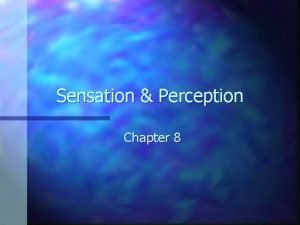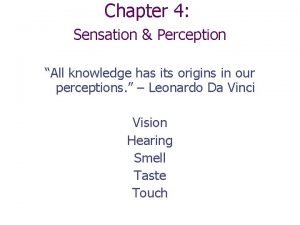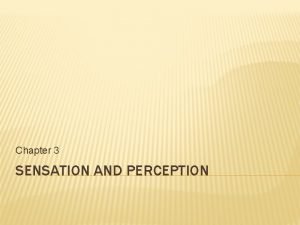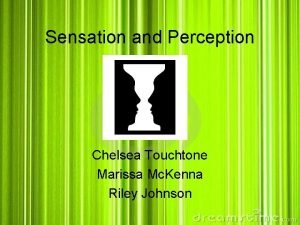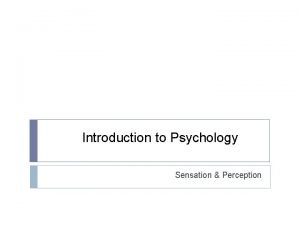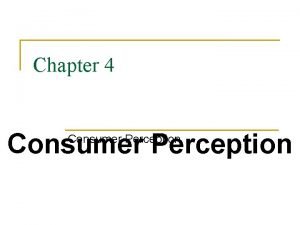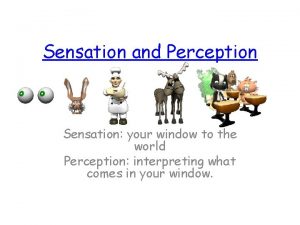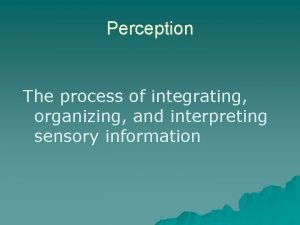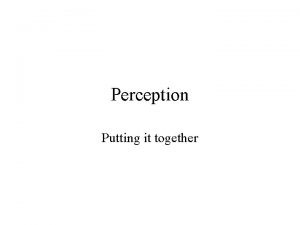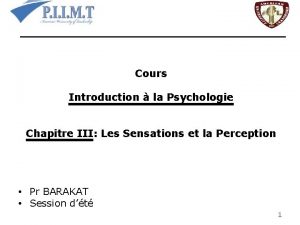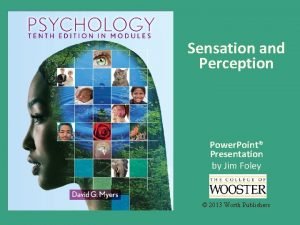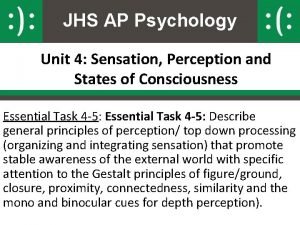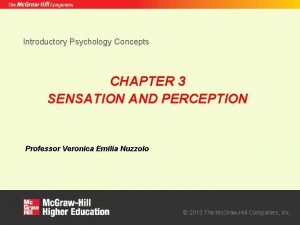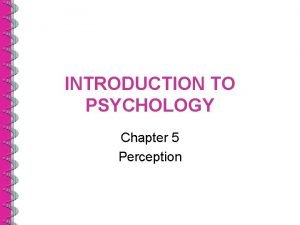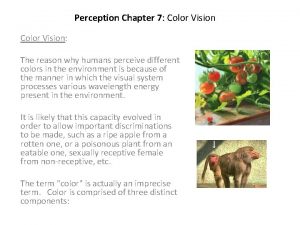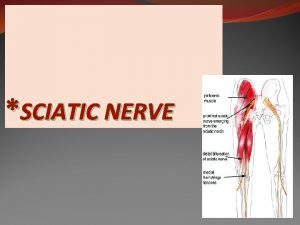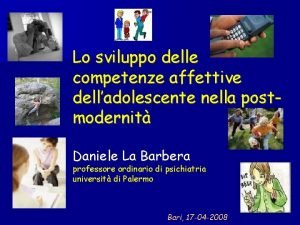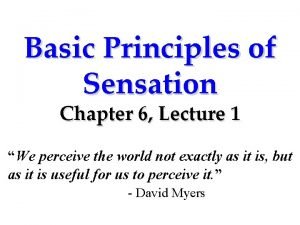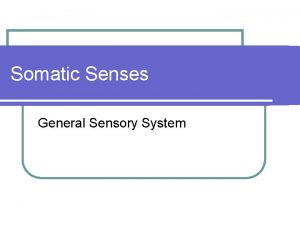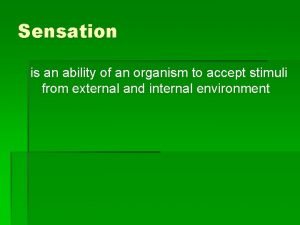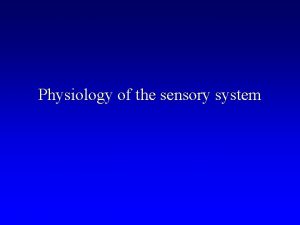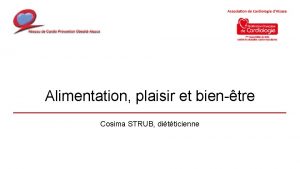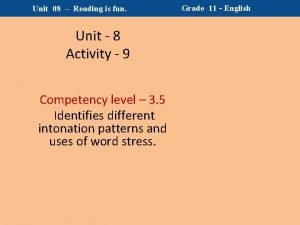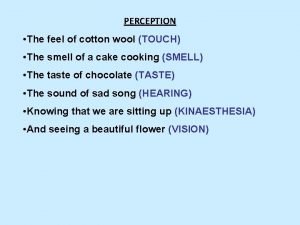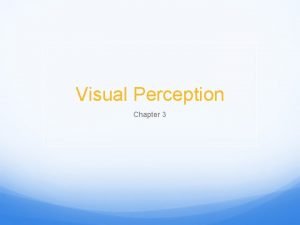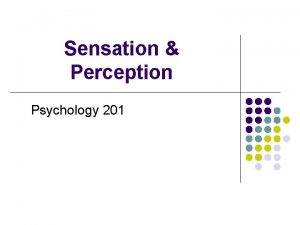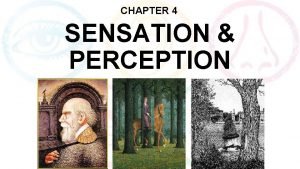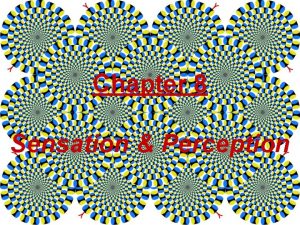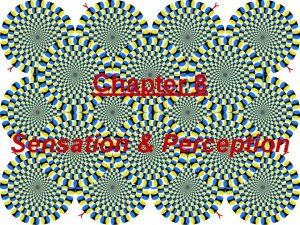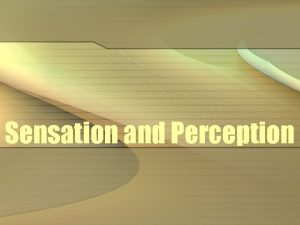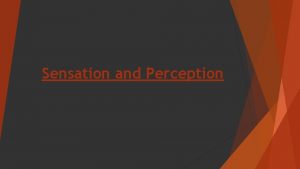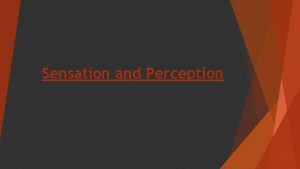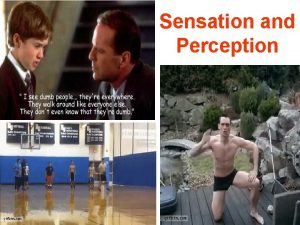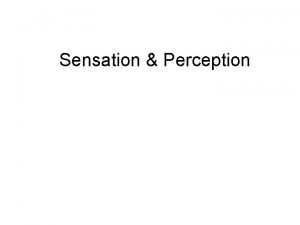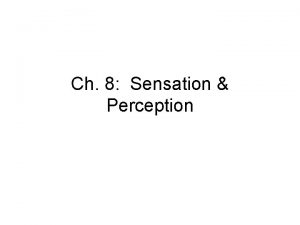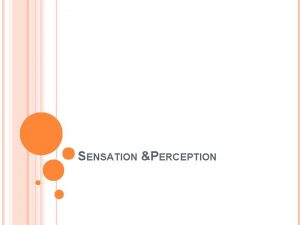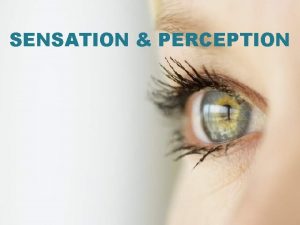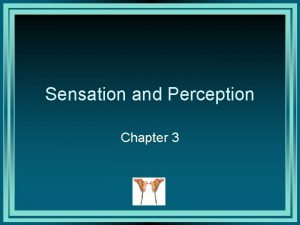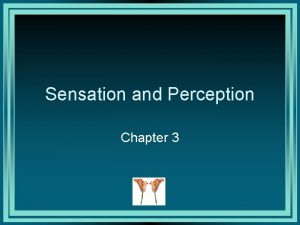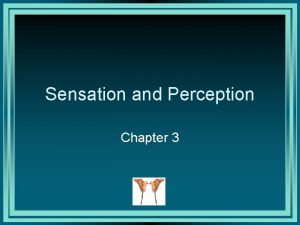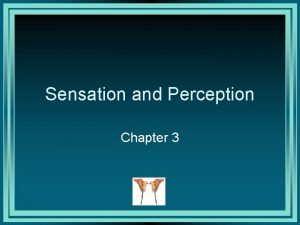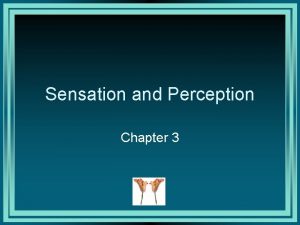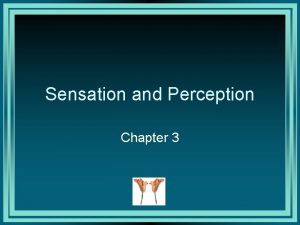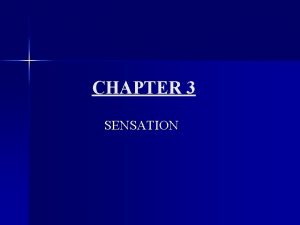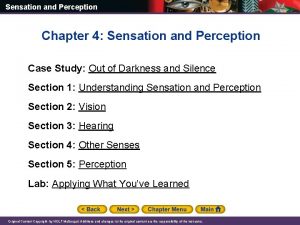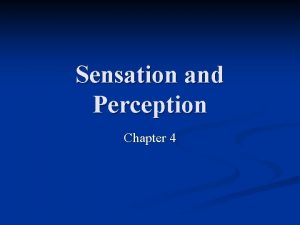Sensation and Perception Chapter 4 AP Psychology The









































- Slides: 41

Sensation and Perception Chapter 4 AP Psychology

The Basics • We do not actually experience the world directly, but instead we experience it through a series of “filters” we call senses. • The study of these sense and their effect on our behavior is called sensory psychology.

Sensation • Sensation: The process by which a stimulated receptor (eyes, ears…) creates a pattern of neural messages that represent the stimulus in the brain, giving rise to our initial experience of the stimulus.

Our Senses • You will notice that all of our sense organs are very much alike. ▫ They all transform physical stimulation (such as light waves or sound waves) into the neural impulses what give us sensations (such as light and dark).

Perception • Perception: A mental process that elaborates and assigns meaning to the incoming sensory patterns. ▫ Perception creates an interpretation of sensation. Do you see faces or vases?

Sensation and Perception • Perception is essentially an interpretation and elaboration of sensation. Therefore, sensation refers to the initial steps in the processing of a stimulus. These pictures should look similar

The True Picture

The Famous Mona Lisa…Frown or Smile

The Famous Mona Lisa…Frown or Smile

Big Idea • Although it seems the brain interacts directly with the outside world, it does not. • The brain senses the world indirectly because the sense organs convert stimulation into the language of the nervous system: neural messages. ▫ In short, the brain never receives stimulation directly from the outside world.

Transduction: Changing Stimulus to Sensation • In all the sense organs, it is the job of sensory receptors to convert incoming stimuli information into electrochemical signals— neural activity. • Transduction: The sensory process that converts energy, such as light or sound waves, into the form of neural messages. Transduction with Hearing

• The neural impulse carries a code of the sensory event in a form that can be further processed by the brain. Light Waves Neural Signals

The Process of Transduction • Transduction begins with the detection by a sensory neuron of a physical stimulus. • When the appropriate stimulus reaches the sense organ, it activates specialized neurons called receptors. • The receptors respond by converting their excitation into a nerve signal. ▫ Think of this as the way a bar-code reader converts a series of lines into an electrical signal that a computer can match with a price.


A Simple Example • Close both of your eyes. Press gently in the corner of one eye. You should “see” a pattern caused by pressure of your finger, not by light. • These light sensations are phosphenes, or visual images caused by fooling your visual system into thinking it sees light.

Sensory Adaptation • Sensation is critically influenced by change. Thus, our sense organs are change detectors. • Their receptors specialize in gathering information about new and changing events.

Sensory Adaptation • Sensory adaptation is the diminishing responsiveness of our sensory systems to prolonged stimulation. • Unless it is quite intense or painful, stimulation that persists without change in intensity usually shifts to the background of our awareness. ▫ Until now, many of you are probably unaware that your sense of touch had adapted to the pressure of the chair against your legs.

Thresholds • What is the weakest stimulus that an organ can detect? • Absolute threshold: The level of stimulus necessary for a stimulus to be detected. ▫ Operational definition of absolute threshold: The presence or absence of a stimulus is detected correctly half the time over many trials.

• Because there is a fuzzy line between detection and nondetection, a person’s absolute threshold is not necessarily absolute. • It varies continually with our mental alertness and physical condition Sense Modality Detection of Threshold Light A candle flame at 30 miles on a dark, clear night. Sound The tick of a mechanical watch under quiet conditions at 20 feet. Taste One teaspoon of sugar in two gallons of water. Smell One drop of perfume diffused into the entire volume of a three-bedroom apartment. Touch The wing of a bee falling on your cheek from a distance of one centimeter.

Thresholds • Difference thresholds: The smallest amount by which a stimulus can be changed and the difference be detected, half of the time. • Think about when you are watching TV and a commercial comes on. Can you tell a difference?

Just Noticeable Difference • Just Noticeable Difference (JND): The minimal amount of change in the signal that is still recognizable. • Just noticeable difference, JND and difference threshold are used interchangeably.

Laws of Sensation • Weber’s Law: to be perceived as different, two stimuli must differ by a constant minimum percentage (rather than a consistent amount. • Fechner’s Law: The size of JND is proportional to the intensity of the stimulus; the JND is large when the intensity of the stimulus is high.

Signal Detection Theory • Signal detection theory says that sensation depends on the characteristics of the stimulus, the background stimulation and the detector. • This theory takes the observer’s characteristics into account and says that stimulus judgment often happens outside of consciousness.

Signal Detection Theory • Signal detection theory recognizes that the observer, whose physical and mental characteristics are always in flux, must compare a sensory experience with ever-changing expectations and biological conditions.

Do Subliminal Messages Work? • Based on studies, some people do respond to stimuli below the absolute threshold, under some circumstances. 100 75 Percentage of correct 50 detections Subliminal stimuli 25 0 Low Medium Absolute threshold Intensity of stimulus ▫ The problem is people have different thresholds at different levels, so what could be subliminal (or below the threshold) for one person, may be supraliminal (above threshold) for another person.

Backmasking- More Subliminal Messaging? Listing to Songs in Reverse • There are legend about hidden messages in songs. Led Zeppelin's Stairway to Heaven was one of the first songs to have supposed hidden, satanic messages. ▫ http: //jeffmilner. com/backmasking. htm • Why does this seem to work?

Perception Chapter 4

Perception • Perception: A mental process that elaborates and assigns meaning to the incoming sensory patterns. ▫ Perception brings meaning to sensation. It produces an interpretation of the world, but it isn’t a perfect representation. We perceive the world not exactly as it is, but as it is useful for us to perceive it.

Describe This Picture The Forest Has Eyes by Bev Doolittle • Bottom-Up: Lines, angles and colors…a guy riding a horse through the forest • Top-Down: We consider the title and direct our attention to aspects that will give meaning to it.

Bottom-Up and Top-Down • Bottom-Up processing: Analysis that emphasizes the characteristics of the stimuli rather than our concepts and expectations. • Top-Down processing / perception: Analysis that emphasizes the perceiver’s expectations, concept memories and other cognitive factors, rather than individual characteristics.

Feature Detectors • Our brains have specialized cells whose job it is to identify specific features of a stimuli. • We do not know how the brain combines these features to make a single percept. This problem is known as the binding problem.

Perceptual Consistency • The ability to recognize the same object as remaining “constant” under changing conditions is called perceptual consistency. ▫ There are three examples of perceptual consistency including size (different distances), color (different lighting) and shape (different angles).

Types of Blindness • Inattentional Blindness: Failing to see visible objects when our attention is directed elsewhere. ▫ Moon-walking Bear • Change Blindness: Failing to notice change in the environment around us. ▫ The switch • Choice Blindness: Failing to notice a change in a previously selected item ▫ Marketplace magic

Context and Expectations • Humans often use context to help interpret out sensations. Once you identify a context, you form expectations about what you are likely to experience. • Context is an enormously useful cue to identify ambiguous stimuli.

Perceptual Set • Perceptual set is a readiness to detect a particular stimulus in a given situation—think of when you are afraid and staying home alone and you notice every noise and think it is a threat. • Here is another example. What is the last word in each line? FOX; OWL; SNAKE; TURKEY; SWAN; D? CK BOB; RAY; DAVE; BILL; TOM; D? CK

Which monster is bigger?

Cultural Influences on Perception • Look at the Ponzo Illusions below. Which Line is longer? Which Elephant is Biggest?

Cultural Influences on Perception • To most of us, like “A” looks longer. Psychologist says this may be a result of the culture we have grown up in which includes structures with long parallel lines that seem to converge in the distance. • People who live in cultures without these such lines, like those in Guam see them as the same length. There are no long, straight railroad tracks or roads in Guam.

Cultural Influences on Perception • Research has supported the conclusion that people who live in cultures without long, parallel figures are less likely to report the top line being the longer figure. • These results strongly support the argument that a person’s experiences affect their perceptions.

• If you assume your senses give you an accurate and undistorted picture of the world, you are probably wrong. If you don’t believe it, try this. • Silently read the backwards statement below. Flip if over in your mind. What does it say? . rat eht saw tac eh. T

Answer • How many people saw this: The cat saw the rat. • Look at it again: . rat eht saw tac eh. T • How many people saw this: The cat was the rat. • Answer: The cat was the tar.
 Psychology chapter 4 sensation and perception
Psychology chapter 4 sensation and perception Chapter 5 sensation and perception
Chapter 5 sensation and perception Chapter 3 sensation and perception
Chapter 3 sensation and perception Chapter 6 sensation and perception
Chapter 6 sensation and perception Five basic taste sensations
Five basic taste sensations Chapter 8 sensation and perception
Chapter 8 sensation and perception Chapter 4 sensation and perception
Chapter 4 sensation and perception What is sensation
What is sensation Visual perception gestalt principles
Visual perception gestalt principles Relative height ap psychology
Relative height ap psychology Sensation example
Sensation example Sensation and perception crossword review
Sensation and perception crossword review Sensation and perception
Sensation and perception Consumer perception definition
Consumer perception definition Webers law
Webers law Sensation and perception
Sensation and perception Sensation and perception uu
Sensation and perception uu Perceptual system
Perceptual system Sensation et perception en psychologie
Sensation et perception en psychologie Perception vs sensation
Perception vs sensation Sensation vs perception
Sensation vs perception Ap psychology unit 4
Ap psychology unit 4 Perception meaning in psychology
Perception meaning in psychology Categorical perception psychology
Categorical perception psychology Interposition psychology definition
Interposition psychology definition Social loafing examples
Social loafing examples Chapter 7 vision and perception
Chapter 7 vision and perception Horizontal e vertical
Horizontal e vertical Sensation seeking
Sensation seeking Sciatic nerve sensory supply
Sciatic nerve sensory supply Sensation seeking significato
Sensation seeking significato 6 principles of sensation
6 principles of sensation Types of sensation
Types of sensation Types of sensation
Types of sensation Cortical sensation
Cortical sensation Does muscle spasms cause burning sensation
Does muscle spasms cause burning sensation Ditticienne base sur coute sensation
Ditticienne base sur coute sensation Ditticienne base sur coute sensation
Ditticienne base sur coute sensation What causes the burning sensation in your muscles
What causes the burning sensation in your muscles Vocabulary activity 8-1 sensation answer key
Vocabulary activity 8-1 sensation answer key Cotton wool sensation
Cotton wool sensation Perception gestalt principles
Perception gestalt principles





